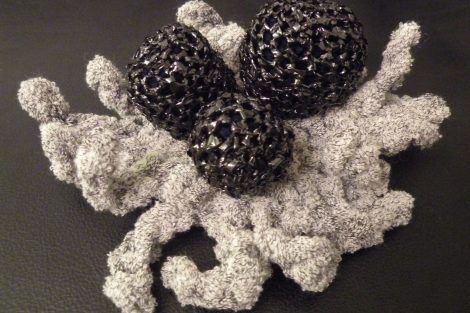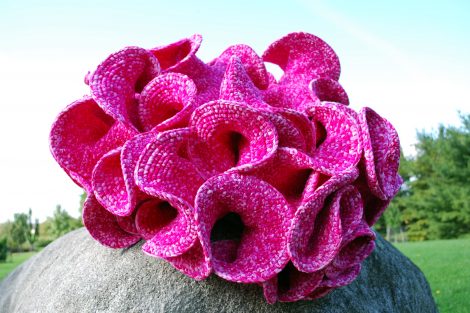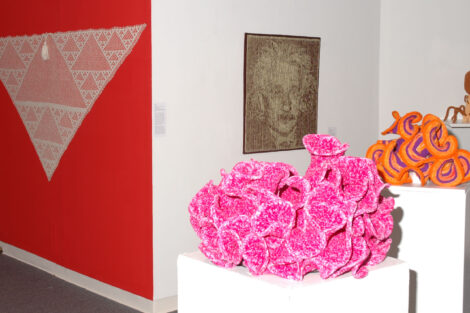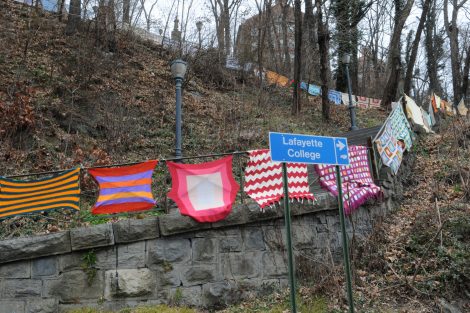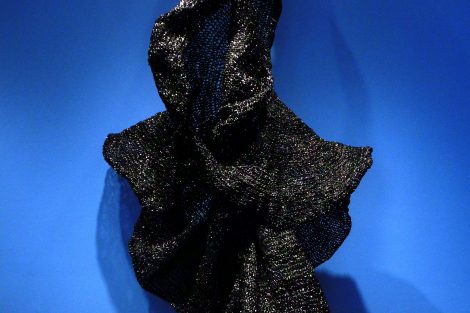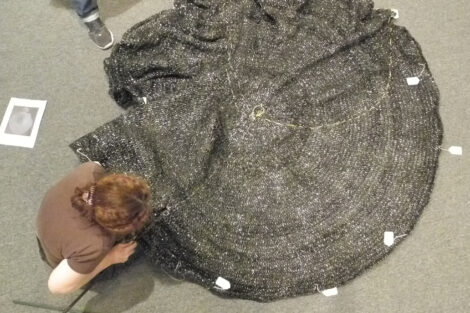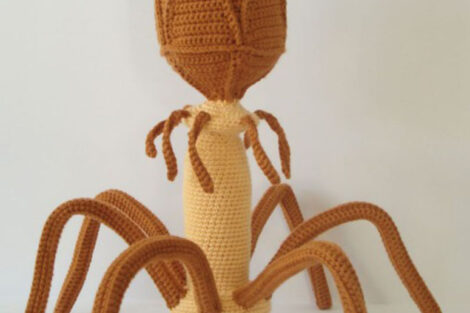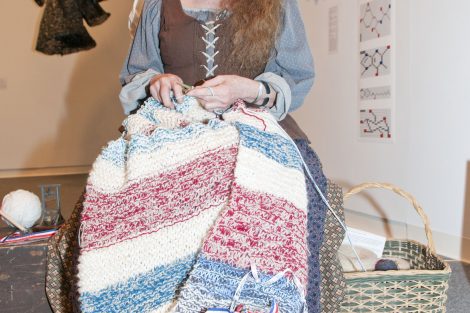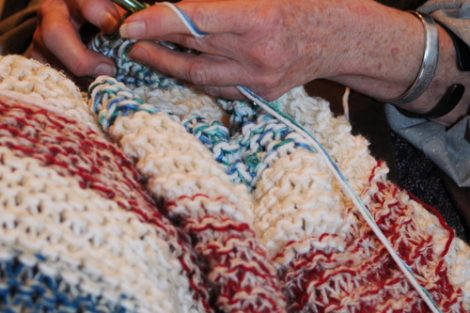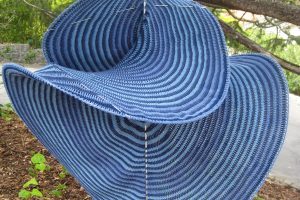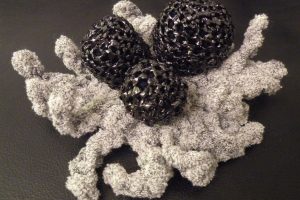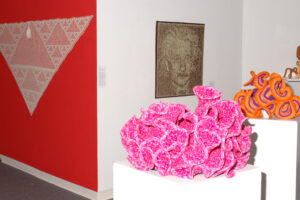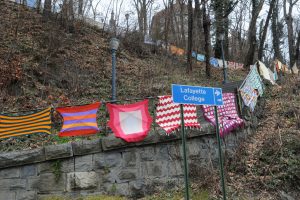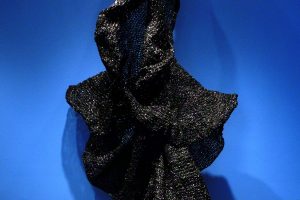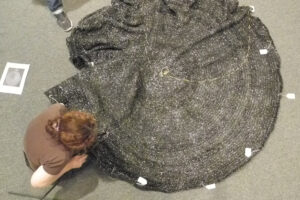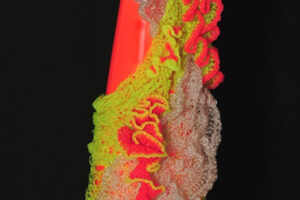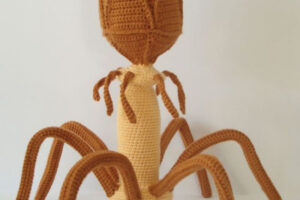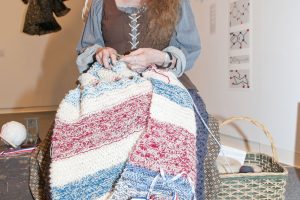Sticks, Hooks, and the Mobius: Knit and Crochet Go Cerebral
January 8–February 5
Sticks, Hooks, and the Mobius: Knit and Crochet go Cerebral
This season’s January exhibition will showcase innovative ways that contemporary knitters and crocheters are redefining a traditional (and traditionally women-based) craft. Included are math and science-based “geek” knit and crocheted art works; Spring Comes Early, a collaborative, community installation; and The Madame deFarge Project, a performance piece by D. Polly Kendrick. The exhibition opens with an outdoor “yarnbombing” event.
Also scheduled are workshops, a knitting/crocheting marathon, and lecture by award-winning author and mathematician Daina Taimina.
Innovative content, experimental materials, community art—from the mundane to the sublime, knitted and crocheted works are showing up on city streets and even in the most venerable galleries, as the rapidly expanding stitch community redefines itself. The message is clear: contemporary knitting and crocheting is artistic, whimsical, inclusive, hip, and contemplative. It is both a revival of—and a progression from—the textile art of the 1960s, 1970s and 1980s.
Guest curator Susan Huxley, a found-object textile artist, is considered among the best in the field of developmental and technical editing of home arts, with publishing houses in the United Kingdom, Canada, and the United States among her many clients. She is also a nationally and internationally published home-arts author and educator.
Math and science-based works in the exhibition include coral-shaped crocheted hyperbolic planes by mathematician Daina Taimina, credited as the first to employ crochet techniques to construct hyperbolic surfaces that vividly illustrate essential features of non-Euclidean geometry Her idea was picked up by The Institute For Figuring and turned into the sensational worldwide ecological Crochet Coral Reef project. A small reef project from the Crochet Guild of America and two works that are part of the Hawaiian reef project are in the exhibition.
Also featured are works by Smith College mathematician sarah-marie belcastro, co- editor of and contributor to Making Mathematics with Needlework: Ten Papers and Ten Projects (A K Peters, 2007), which contains not only instructions for creating mathematical objects but also insights into the underlying mathematics.
Included in the exhibition is a wall of mobius, a circle with a twist that creates a single edge, created by mathematicians, members of the Easton Saturday Stitchers, a New Jersey spinning guild, and other invited stitchers.
Local mill Kraemer Yarns of Nazareth has provided yarn for a Sierpinski Triangle, stitched by Elinor Levy of Easton from instructions by mathematician David Jacob (Jake) Wildstrom of the University of Louisville. The Sierpinski is a fractal and attractive fixed set named after the Polish mathematician Wacław Sierpiński who described it in 1915. It is one of the basic examples of self-similar sets, i.e. it is a mathematically generated pattern that can be reproducible at any magnification or reduction.
There’s a knit interpretation of a computer motherboard and a knit translation of binary code that’s a work-in-progress with resistors used as stitch markers; a bacteriophage by Susan Burkhart, glow-in-the-dark jellyfish; a human heart, and an eyeball.
Dainia Taimina will present a lecture on Sunday afternoon, February 5 , during the closing reception.
The Mathematical Association of America selected Daina Taimiņa‘s Crocheting Adventures with Hyperbolic Planes (AK Peters; 2009) as the winner of the 2012 Euler Book Prize, given to the author or authors of an outstanding book about mathematics.
The award announcement describes the book as “a novel approach to geometry that has brought a whole new audience to mathematics. In this respect it has greater outreach potential than any book we have previously considered. But it is much more than that; it is perfectly capable of standing on its mathematical feet as a clear, rigorous, and beautifully illustrated introduction to hyperbolic geometry. It is truly a book where art, craft, science, and mathematics come together in perfect harmony.”
On January 8, the day of the opening reception, Huxley will lead a “yarn bombing” on the staircase from the archway on North Third Street up the hillside toward campus. Lafayette and Easton community members are encouraged to help attach a collection of 40 knitted and crocheted afghans to the handrails of the staircase as a visual symbol of the relationship between the town and the college. The colorful afghans will also beautify a stark winter urban landscape, which is one of the primary intents of the “yarn bombing/knit graffiti” trend.
Huxley has spent six month collecting afghans from thrift shops. “Most have never been used,” she says. “Stitching is a personal, time-consuming process not undertaken lightly, so the people who tossed away these afghans are basically refusing to acknowledge the gift of time and love and showing a lack of respect for women’s work. I want people to react to the hanging afghans. Some, who understand what’s involved in making them, will think it’s horrible to leave them outside for a month. Others will complain that they’re ugly and should be removed. And I hope some will begin to discover the beauty of the stitching and color combinations.”
Easton artist D. Polly Kendrick will be in the gallery knitting a shroud as part of her Madame deFarge Project.
Kendrick says, “I have always been drawn to the role of constructive string manipulation in the story of women’s lives: [The Odyssey’s] Penelope and her alternate weaving and unraveling to keep her ardent suitors at bay; the princess in the Rumplestiltskin tale striving to learn the secret of spinning straw into gold; Charlotte, whose literate web saved Wilbur; and most particularly Madame deFarge [from Charles Dickens’ A Tale of Two Cities] sitting at the base of the guillotine, knitting the names of doomed aristocrats into a shroud.”
To create her version of the infamous shroud, Kendrick asked friends and relatives to write on pieces of tri-colored ribbon “the things they would most like to get out of their lives—not just the names of those people and things that everyone might like see trundling off in a tumbrel to the steps of that same guillotine but would also include representations of toxic emotions, habits, and lifestyles that need to be sliced from this world.” The ribbon scraps are then knit into this contemporary interpretation of Madame deFarge’s shroud.
In the collaborative installation Spring Comes Early, an invasive, rapidly growing regional species of vine (or a fantasy “vine of knowledge”) will take over a section of the Williams Center Gallery, starting from a simple pot on a reception desk, crawling over and around the desk, up the window and wall, out into the lobby and across the floor. It is eventually covered with accurate and not-so-accurate stitched flowers, leaves, birds, bird’s nests, and bugs. Susan Huxley will offer Build-a-Bug and Bird’s Nest workshops for children, and a session on making flowers for adults.

